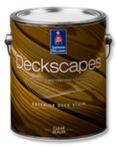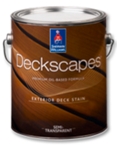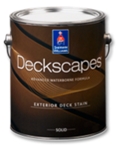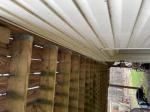Deck Finishing Procedure and Products
If you have cleaned your deck thoroughly, finishing is the next step.
Proper deck finishing must begin with preparing the deck surface.
For finish, stain, or sealant to adhere properly, the best thing you can do is take an orbital hand sander and lightly sand the surface with an 80-grit paper. This step prepares the wood surface perfectly for the stain or finish.
Lightly sanding your deck will add some extra time to your efforts but this step will prolong the finish for an additional year or two.
So, over the long haul it will save you time and that is why I recommend you seriously consider taking this step.
Apply a Surface Finishing Coat
After the deck boards have had a few days of warm weather to dry
out you can apply your finish coat.
IMPORTANT: If the deck boards are still moist the finish coat will not adhere properly.
To apply your finish, use the garden sprayer and take care to avoid over spray near the sides of the house. You can also use a flat brush that kind of pushes the finish or rubs it onto the material. A roller is not recommended as it can often overload the deck with too much finish.
What Type of Deck Finishing Product Should You Use?
There are 3 commonly used deck finishes.
Each one has unique characteristics, and you should be aware of them to choose the right finish for your deck.
Clear Finish
These products go on clear and add minimal to no coloration to the wood.
They typically contain only a water repellant and sometimes preservatives. They do not usually last as long as an alkyd stain that penetrates the wood.
Some clear finishes however are also penetrating as they contain oils and are absorbed into the wood providing a longer lasting finish.
This example is from Sherwin-Williams but there are also many other good products from other manufacturers.
Semi-Transparent (alkyd stains)
These are also known as penetrating finishes because they are more opaque in color and the grain is still visible.
This is a good example of semi-transparent stain from Sherwin-Williams.
They soak into the wood and never peel off - supposedly. They eventually fade and then it is time to re-apply. Lots of companies make similar high-quality products. However, each product can be different.
The most important recommendation is to avoid applying under direct sunlight as the deck surface gets quite hot and cause problems with proper adhesion. Secondly, do not use a roller. Use one of those flat brushes which allows you to apply a very thin coat. Thinner coats are much better and less likely to bubble up and peel.
Solid Stain or Paint
This kind of finish sits on top of the deck surface and has pigment for
color.
Here is a Sherwin-Williams product representing the solid stain category. Solid stains or paint do not withstand the wear and tear placed on horizontal surfaces very well, so they are not recommended for decks unless you are prepared to re-apply them annually.
They tend to crack and peel and are best suited for siding or fences rather then deck finishes.
Deck Finishes Contain Some or all of These Ingredients
Every finishing product is made up of one or a combintation of the following compounds.
Oils, Parrafins and Resins
Oils or parrafins repel water and are mixed with an agent to spread the finish. Thompsons Water seal is a good example of a parrafin based coating. But it requires a bi-annual application to really be effective.
Oils also repel water but soak into the wood deeply so they last longer.
Resins are longer lasting and more expensive. The nice thing about resin finishes is they don't harden like a varnish but actually soak into the wood. They are also known as alkyd resin.
Preservatives
Some finishes also contain preservatives to prevent mildew and mold from forming. This is a great quality especially if you live in an area subject to a lot of rain or moisture.
UV Inhibitors
UV inhibitors provide protection against the rays of the sun and are designed to prevent or slow the discoloration process of the exposed wood.
Hopefully this explanation has answered all of your questions about deck finishing.
So get out there and make your deck look great for another season!
Home > Cleaning Wood Decks > Deck Finishing






























